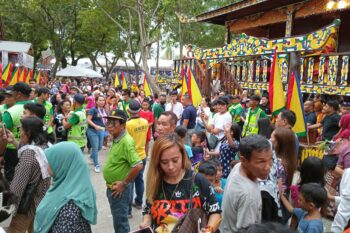GENERAL SANTOS CITY (MindaNews/15 April) — The Department of Science and Technology (DOST) has installed a total of 72 weather monitoring systems in various parts of Region 12 in the last three years.
Zenaida Hadji Raof-Laidan, DOST Region 12 director, said Wednesday they completed last month the second phase of the project, which is part of its Project Nationwide Operational Assessment of Hazards or Project NOAH.
The initiative is the agency’s response to the call of President Benigno S. Aquino III for the implementation of “more accurate, integrated and responsive disaster prevention and mitigation system” in parts of the country.
Under the program, she said they were able to install 47 automated rain gauges, 16 water level monitoring systems (WLMS), four automated weather stations and six non-bridge WLMS.
“These were deployed in identified high-risk areas in the region to ensure the proper monitoring of weather changes and at the same time help communities prepare against possible weather-related disasters,” she said.
Laidan said the rain gauges were installed in South Cotabato (11), North Cotabato (18), Sultan Kudarat (11), and Sarangani (6).
The water level monitoring systems were installed in South Cotabato (5), North Cotabato (5), Sultan Kudarat (5) and Sarangani (1).
A weather station was put up in each of the following areas: South Cotabato, Sultan Kudarat, Sarangani and Cotabato City.
Three non-bridge WLMS were installed in this city, two in Makilala, North Cotabato and one in Polomolok, South Cotabato.
DOST-12 started the deployment of the devices in 2012 under the first phase of the nationwide initiative.
“These systems are now fully functioning and provide real-time weather monitoring data,” Laidan said.
A DOST-12 briefer described the automated weather station as a “modern weather tracking device that can do remote meteorological measurements and send data on real-time basis.”
It said each station is equipped with sensors capable of measuring weather parameters, wind speed and directions, air temperature, air humidity, air pressure as well as rain volume, duration and intensity.
The agency said the rain gauges were developed to gather and record the amount of rainfall over a set period of time.
“Weather and rainfall data are sent wirelessly through a cellular network as a short message system or text message. Each station is equipped with the data-logger platform GSM Data Acquisition Terminal (GDAT), which serves as a mini-computer or brain that intelligently controls all the functions and data communications of the station,” it said.
The GDAT technology was developed by the DOST’s Advanced Science and Technology Institute.
The WLMS features sensors that are installed in rivers and bridges to monitor how fast the water level rises during rains.
“The deployment of these modern weather tracking equipment would eliminate subjective weather forecasting. It would facilitate real-time monitoring of weather disturbances and eventually help keep our communities alert to possible calamities brought about by heavy rains and typhoons,” Laidan said.
The official said the program does not end up with the deployment of the monitoring systems.
“We will conduct periodic monitoring, maintenance and evaluation to sustain the performance of the stations,” she added. (MindaNews)
